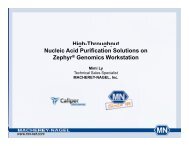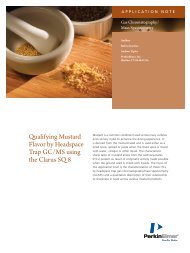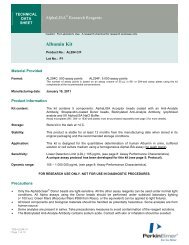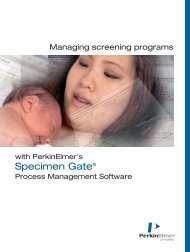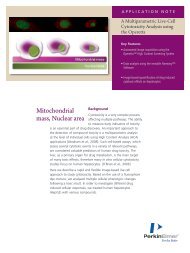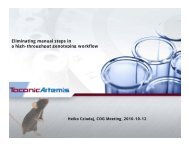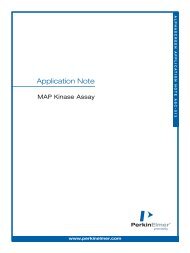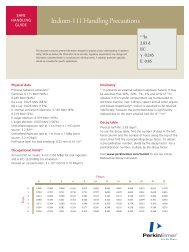A Practical Approach to Cell Signaling Pathway Analysis - PerkinElmer
A Practical Approach to Cell Signaling Pathway Analysis - PerkinElmer
A Practical Approach to Cell Signaling Pathway Analysis - PerkinElmer
You also want an ePaper? Increase the reach of your titles
YUMPU automatically turns print PDFs into web optimized ePapers that Google loves.
A <strong>Practical</strong> <strong>Approach</strong> <strong>to</strong><br />
<strong>Cell</strong> <strong>Signaling</strong> <strong>Pathway</strong> <strong>Analysis</strong><br />
From sensitive western blots <strong>to</strong> quantitative assays of<br />
multi-target pathways using AlphaScreen® SureFire® assays<br />
Introduction<br />
application note<br />
Author<br />
Stephen Hurt, PhD<br />
and David Titus, PhD<br />
<strong>PerkinElmer</strong>, Inc.<br />
710 Bridgeport Avenue<br />
Shel<strong>to</strong>n, CT USA<br />
<strong>Cell</strong>ular kinase signal transduction pathways are involved in the regulation of many important cellular processes such<br />
as cell survival, differentiation and apop<strong>to</strong>sis. Kinase signaling networks are typically characterized by multiple kinases<br />
arranged in cascades containing nodes with feedback loops, and crosstalk between pathways. One of the most widely<br />
studied pathways is the phosphoinositide-3 kinase (PI3K) pathway (Figure 1), which contains the downstream kinases<br />
Akt and mTOR (mammalian target of rapamycin). Genetic mutations resulting in abnormal activation of the PI3K pathway<br />
are found in a high number of human cancers. Therefore, inhibi<strong>to</strong>rs targeting PI3K and other components in the pathway<br />
are potential drugs for cancer therapy.<br />
Akt, also known as protein kinase B, is a central effec<strong>to</strong>r in the PI3K pathway. A common mechanism for controlling<br />
the activity of a kinase is phosphorylation on serine, threonine, or tyrosine residues. Akt is activated by phosphorylation<br />
on threonine residue T308 by PDK1, and on serine S473 by the mTOR Complex 2 (mTORC2). Upon activation, Akt<br />
phosphorylates several downstream targets culminating in the regulation of cell survival and metabolism. In this study,<br />
we stimulated MCF7 cells with insulin-like growth fac<strong>to</strong>r 1 (IGF-1) <strong>to</strong> activate the PI3K/Akt pathway. Conversely, the<br />
pathway inhibi<strong>to</strong>rs wortmannin and rapamycin were used <strong>to</strong> block the activity of PDK1 and mTOR Complex 1<br />
(mTORC1), respectively.<br />
Numerous assay technologies have been developed for studying kinase signaling pathways, and for screening compound<br />
libraries in search of agents <strong>to</strong> modify kinase activities. Depending on the stage of the investigation and the<br />
antibody reagents available <strong>to</strong> the researcher, both western blot and AlphaScreen ® SureFire ® assays can yield valuable<br />
information. Western blots are widely used for studies of cellular kinases, but these assays suffer from limited sensitivity<br />
and throughput. We demonstrate here that an ultra-sensitive western blot substrate (Western Lightning Ultra) increases<br />
detection sensitivity 5-10 fold, enabling much more robust detection of phosphorylated targets in cellular extracts.<br />
<strong>PerkinElmer</strong> products used in this study:<br />
AlphaScreen ® SureFire ® assay kits<br />
(Akt pathway, p-PDK1, GAPDH)<br />
AlphaScreen ® Protein A detection kit<br />
Western Lightning Ultra chemiluminescent substrate<br />
Western Lightning Plus ECL<br />
ViewPlate ® -96 TC<br />
ProxiPlate-384 Plus<br />
PolyScreen ® PVDF Transfer Membranes<br />
EnVision ® Multilabel Plate Reader<br />
JANUS ® Au<strong>to</strong>mated Workstation
2<br />
GSK3<br />
Glycogen<br />
Synthesis<br />
IGF-1<br />
Recep<strong>to</strong>r<br />
PI3K mTORC1p70S6K<br />
PDK1<br />
AKT<br />
4E-BP1<br />
Protein<br />
Translation<br />
Figure 1. The PI3K/Akt cellular signaling pathway<br />
AlphaScreen ® SureFire ® technology<br />
AlphaScreen ® SureFire ® cellular kinase assays measure endogenous<br />
levels of phosphorylated cellular proteins involved in various<br />
signaling pathways. The assay is a homogeneous, bead-based<br />
technology that utilizes two antibodies in a sandwich assay<br />
format. One antibody recognizes a specific phospho-epi<strong>to</strong>pe<br />
on the analyte, while the other antibody is directed <strong>to</strong>wards<br />
another, non-phosphorylated, epi<strong>to</strong>pe on a distal part of the<br />
analyte. One of the antibodies binds <strong>to</strong> a Donor bead and the<br />
other <strong>to</strong> an Accep<strong>to</strong>r bead, so that in the presence of a phospho-<br />
protein the two beads are drawn in<strong>to</strong> close proximity. Excitation<br />
of the Donor bead with laser light with a wavelength of 680 nm<br />
results in energy transfer <strong>to</strong> the Accep<strong>to</strong>r bead yielding an<br />
emission signal at 520-620 nm.<br />
Figure 2. AlphaScreen® SureFire® assay principle<br />
<strong>Cell</strong> culture<br />
mTORC2<br />
MCF7 cells were cultured in T75 flasks in EMEM supplemented<br />
with 10% FBS. <strong>Cell</strong>s were maintained in culture at 20-70%<br />
confluency and typically were passed twice per week.<br />
S6 RP<br />
We further compared the detection of multiple phosphorylated<br />
targets using AlphaScreen ® SureFire ® assays of cellular kinase<br />
activity. Our data indicates that AlphaScreen ® SureFire ® assays<br />
for several targets in the PI3 signaling pathway give results<br />
comparable in sensitivity <strong>to</strong> ultra-sensitive western blots, but<br />
with higher throughput and a much less time-consuming pro<strong>to</strong>col.<br />
Modulation of kinase pathways generally affects multiple<br />
kinases in the pathway. AlphaScreen ® SureFire ® assays are<br />
well-suited for kinase pathway mapping, since the assay requires<br />
only 4 µL of cellular lysate per assay point.<br />
The results of cell-based assays can be affected by variability in<br />
the number of cells sampled per assay point. A common method<br />
for controlling for variability is <strong>to</strong> normalize the assay signal <strong>to</strong><br />
a cellular protein whose level does not change as a function of<br />
the assay. We have validated two targets for normalization of<br />
the PI3K/Akt pathway. The first is the metabolic enzyme GAPDH,<br />
and the second is the <strong>to</strong>tal Akt present in the cell.<br />
Western Lightning Ultra chemiluminescent substrate<br />
The high sensitivity and broad dynamic range of the Western<br />
Lightning Ultra substrate make it ideal for investigation of cell<br />
signaling pathways, where concentration of targets of interest<br />
can vary widely.<br />
<strong>Cell</strong> lysate preparation<br />
Flasks of confluent cells were stimulated for 20 minutes at room<br />
temperature with 200 nM IGF-1 in complete medium. The<br />
medium was removed and the cells were lysed with 5 mL of<br />
lysis buffer for 10 minutes with gentle shaking. The lysate was<br />
centrifuged <strong>to</strong> remove solid cell debris and the supernatant was<br />
collected and frozen in aliquots at -80 °C. <strong>Pathway</strong> inhibition was<br />
performed by treating the cells with a combination of 20 µM<br />
wortmannin and 200 nM rapamycin in complete medium for<br />
2 hours at 37 °C, 5 % CO 2 . <strong>Cell</strong>s were serum-starved by<br />
incubation in base medium for 3 hours at 37 °C, 5 % CO 2 .<br />
Western blot analysis<br />
Protein concentration in MCF7 cell lysates was determined by<br />
the BCA protein assay with bovine serum albumin as the standard.<br />
Western blot analysis was performed by resolving cell lysates<br />
loaded at 20 µL/lane on NuPAGE ® Novex ® polyacrylamide mini<br />
gels followed by transfer of the proteins <strong>to</strong> PVDF membranes.<br />
The membranes were probed with the same primary antibodies<br />
<strong>to</strong> phospho-proteins contained in the AlphaScreen ® SureFire ®<br />
kits, followed by exposure <strong>to</strong> anti-species HRP-conjugated<br />
secondary antibodies. The membranes were treated with the<br />
chemiluminescent substrate for 1 minute, and the image was<br />
acquired on a Kodak Image Station 440 CF imager.
AlphaScreen ® SureFire ® assay pro<strong>to</strong>col<br />
A 4 µL aliquot of lysate was added <strong>to</strong> the well of a ProxiPlate.<br />
A 5 µL mixture of Reaction buffer, Activation buffer, and<br />
AlphaScreen Protein A Accep<strong>to</strong>r beads (40:10:1) was added<br />
and the plate was incubated at room temperature for 2 hours.<br />
Two µL of AlphaScreen streptavidin-coated Donor beads in<br />
AlphaScreen ® SureFire ® Dilution buffer (20:1) was added and<br />
the plate was incubated for an additional 2 hours. The plate<br />
was then read on an EnVision ® Multilabel Plate Reader using<br />
the fac<strong>to</strong>ry defined AlphaScreen settings.<br />
Using a frozen aliquot of<br />
treated cells, perform<br />
parallel analysis of<br />
targets in AKT signaling<br />
pathway. 5 hrs<br />
Using a frozen aliquot<br />
of treated cells,<br />
perform western blot<br />
confirmation of selected<br />
assay results.<br />
Treat cells in culture<br />
flask or microplate.<br />
10-60 min<br />
Lyse cells and collect<br />
supernatant. Freeze<br />
aliquots at -80 °C.<br />
30 min<br />
Analyze phospho-AKT<br />
levels using<br />
AlphaScreen ®<br />
SureFire ® assay. 5 hrs<br />
Positive results Negative results<br />
<strong>Pathway</strong> mapping workflow<br />
The workflow shown in Figure 3 illustrates an efficient and<br />
cost-effective approach <strong>to</strong> cell signaling pathway analysis.<br />
By freezing multiple aliquots of the stimulated cell lysate at<br />
-80 °C, a first-pass analysis of one phosphorylated target can<br />
be followed by a more extensive analysis using the full range<br />
of AlphaScreen ® SureFire ® assays available for a given pathway.<br />
Confirma<strong>to</strong>ry western blots can then be performed on the<br />
same samples only as needed.<br />
Try another<br />
cell treatment<br />
Figure 3. A workflow for efficient analysis<br />
of cell signaling pathways.<br />
3
4<br />
Western Lightning Ultra Western Lightning Plus<br />
Results<br />
<strong>Cell</strong> lysate loaded [ug/well]<br />
16 8 4 2 1 0.5<br />
Figure 4. Sensitivity of detection using Western Lightning Ultra compared <strong>to</strong> Western Lightning Plus.<br />
Ultra-sensitive western blot<br />
Two western blots were run using the same aliquot of lysate<br />
from cells stimulated with IGF-1. Two-fold serial dilutions of<br />
lysate were performed <strong>to</strong> determine assay sensitivity. The<br />
membranes were probed with antibody <strong>to</strong> <strong>to</strong>tal Akt, and<br />
detected with either Western Lightning Ultra or Western<br />
Lightning Plus. The results shown in Figure 4 demonstrate that<br />
5-10 fold greater sensitivity is obtained with Western Lightning<br />
Ultra as the substrate.<br />
Western blot sensitivity compared <strong>to</strong><br />
AlphaScreen ® SureFire ®<br />
The sensitivity of western blot assays using Western Lightning<br />
Ultra was compared <strong>to</strong> the sensitivity of AlphaScreen ® SureFire ®<br />
assays in detecting seven phosphorylated proteins in the PI3K/Akt<br />
signaling pathway. The components tested ranged from PDK1<br />
at the beginning of the pathway <strong>to</strong> the final downstream targets,<br />
p-4E-BP1 and p-S6 RP, and included both phosphorylation sites<br />
on Akt. Serial dilutions of lysates of IGF-1 stimulated cells show<br />
comparable sensitivity of detection by both assay technologies<br />
as presented in Figure 5 (next page).<br />
PI3K/Akt pathway mapping: basal vs. stimulated cells<br />
AlphaScreen ® SureFire ® assays were used <strong>to</strong> measure the level<br />
of phosphorylated substrates in the PI3K/Akt pathway compared<br />
<strong>to</strong> their basal level in cells stimulated with IGF-1. As shown in<br />
Figure 6, four members of the pathway, p-Akt (T308), p-Akt<br />
(S473), p-p70 S6K and p-S6 RP exhibited a stimulated response<br />
from 2-20 fold greater than their basal level. The other three<br />
pathway components did not show stimulation significantly<br />
above their basal level.<br />
PI3K/Akt pathway mapping: basal vs. serum<br />
starved vs. inhibited cells<br />
The targets that had shown significant basal levels as described<br />
above were further studied by either serum starving the cells or<br />
treating them with pathway inhibi<strong>to</strong>rs. Inhibition was performed<br />
using a combination of two inhibi<strong>to</strong>rs, wortmannin and<br />
rapamycin, <strong>to</strong> ensure maximal inhibition. As observed in Figure 7,<br />
serum starvation reduces the signal for these targets except<br />
p-S6 RP. <strong>Pathway</strong> inhibition reduced the signal <strong>to</strong> a greater<br />
extent than serum starvation for all of the targets.<br />
800,000<br />
700,000<br />
600,000<br />
500,000<br />
400,000<br />
300,000<br />
200,000<br />
100,000<br />
400,000<br />
300,000<br />
200,000<br />
100,000<br />
<strong>Cell</strong> lysate loaded [ug/well]<br />
16 8 4 2 1 0.5<br />
0<br />
0<br />
p-PDK1<br />
p-Akt (T308)<br />
p-Akt (S473)<br />
p-P70 S6K<br />
p-GSK3<br />
p-S6 RP<br />
p-4E BP1<br />
Basal<br />
Stimulated<br />
Figure 6. Comparison of basal vs. stimulated level of phospho-proteins in the<br />
PI3K/Akt pathway in cells stimulated with IGF-1.<br />
Basal<br />
Inhibited<br />
Serum Starved<br />
Figure 7. Effect of serum starvation or pathway inhibition on MCF7 cells.
p-AKT<br />
Thr 308<br />
p-AKT<br />
Ser 473<br />
p-PDK1<br />
Ser 241<br />
p-GSK3a<br />
Ser 21<br />
p-p70S6K<br />
Ser 389<br />
P-4E BP1<br />
Thr 37/46<br />
p-S6 RP<br />
Ser 240/244<br />
Signal (counts)<br />
AlphaScreen ® SureFire ® p- AKT (T308)<br />
300,000<br />
250,000<br />
200,000<br />
150,000<br />
100,000<br />
50,000<br />
250,000<br />
200,000<br />
150,000<br />
100,000<br />
50,000<br />
150,000<br />
100,000<br />
50,000<br />
0<br />
34001700 850 425 212 106 53<br />
ng of lysate/well<br />
27 14<br />
AlphaScreen ® SureFire ® p- AKT (Ser473)<br />
0<br />
34001700 850 425 212 106 53<br />
ng of lysate/well<br />
27 14<br />
AlphaScreen ® SureFire ® p-PDK1 (Ser241)<br />
0<br />
34001700 850 425 212 106 53<br />
ng of lysate/well<br />
27 14<br />
AlphaScreen ® SureFire ® p-GSK3 α (Ser21)<br />
450,000<br />
400,000<br />
350,000<br />
300,000<br />
250,000<br />
200,000<br />
150,000<br />
100,000<br />
50,000<br />
0<br />
34001700 850 425 212 106 53 27 14<br />
800,000<br />
700,000<br />
600,000<br />
500,000<br />
400,000<br />
300,000<br />
200,000<br />
100,000<br />
250,000<br />
200,000<br />
150,000<br />
100,000<br />
50,000<br />
300,000<br />
200,000<br />
100,000<br />
ng of lysate/well<br />
AlphaScreen ® SureFire ® p-p70 S6K (Ser389)<br />
0<br />
34001700 850 425 212 106 53<br />
ng of lysate/well<br />
27 14<br />
AlphaScreen ® SureFire ® p-4E-BP1 (T37/46)<br />
0<br />
34001700 850 425 212 106 53<br />
ng of lysate/well<br />
27 14<br />
AlphaScreen ® SureFire ® p-S6 RP (Ser240/244)<br />
0<br />
34001700 850 425 212 106 53<br />
ng of lysate/well<br />
27 14<br />
Figure 5. Sensitivity of detection of ultra-sensitive western blot compared <strong>to</strong> AlphaScreen® SureFire® in detecting targets<br />
in the PI3K/Akt pathway.<br />
5
6<br />
700,000<br />
600,000<br />
500,000<br />
400,000<br />
300,000<br />
200,000<br />
100,000<br />
GAPDH Lysate Titration<br />
0<br />
0 100 200<br />
ng of lysate/well<br />
300 400<br />
Assay normalization – GAPDH and <strong>to</strong>tal Akt<br />
In order <strong>to</strong> normalize AlphaScreen ® SureFire ® assays <strong>to</strong> account<br />
for well-<strong>to</strong>-well variability in cell number or daily fluctuations in<br />
the cellular metabolic state, two approaches were examined.<br />
The first was <strong>to</strong> use the level of the metabolic enzyme GAPDH<br />
for normalization, and the second <strong>to</strong> normalize against <strong>to</strong>tal<br />
Akt. Prior <strong>to</strong> running the GAPDH assay we found it is necessary<br />
<strong>to</strong> dilute the lysate so that the concentration of GAPDH is<br />
below the “hook point” of the assay. At the “hook point” of<br />
the assay binding <strong>to</strong> either the Donor or Accep<strong>to</strong>r bead is saturated,<br />
and the maximal assay signal is generated. Above this<br />
point the beads are oversaturated with analyte, which inhibits<br />
their association and causes a progressive signal decrease.<br />
Figure 8 shows the GAPDH signal obtained from a serial dilution<br />
of lysate indicating that at least a fifty-fold dilution is necessary<br />
for MCF7 cells.<br />
To verify that GAPDH and <strong>to</strong>tal Akt were suitable analytes for<br />
normalization, MCF7 cells were stimulated with IGF-1 for a<br />
range of time points from 5 minutes <strong>to</strong> one hour. Lysates were<br />
prepared for each time point and were assayed for GAPDH,<br />
<strong>to</strong>tal Akt and p-Akt (S473). The results plotted in Figure 9<br />
show that the level of p-Akt (S473) varies over time, whereas,<br />
GAPDH and <strong>to</strong>tal Akt levels remain constant.<br />
500,000<br />
400,000<br />
300,000<br />
200,000<br />
100,000<br />
0<br />
Agonist Stimulation Time<br />
Figure 8. GAPDH signal for a dilution series of MCF7 cellular lysate. Figure 9. Time course of detection of GAPH, <strong>to</strong>tal Akt, and p-Akt.<br />
Summary<br />
GAPDH<br />
Total Akt<br />
p-Akt (S473)<br />
Ultra-sensitive western blot analysis has been compared <strong>to</strong><br />
AlphaScreen ® SureFire ® assays for detecting multiple analytes<br />
in the PI3K/Akt cellular kinase pathway. Western blot using<br />
Western Lightning Ultra substrate detects phosphorylated targets<br />
in cell lysates 5-10 fold better than standard western blot<br />
reagents. This provides greater dynamic range, which helps in<br />
quantitative comparisons of phosphorylation levels. AlphaScreen ®<br />
SureFire ® assays show comparable detection sensitivity. The<br />
homogeneous format of AlphaScreen ® SureFire ® assays offers<br />
higher throughput with a much simpler pro<strong>to</strong>col.<br />
The two assay technologies have complementary features that<br />
make each the preferred method at different stages in the<br />
assay development and execution process. The table below<br />
summarizes the most important characteristics of each technology.<br />
We recommend using western blot when beginning assay<br />
development, and then moving <strong>to</strong> AlphaScreen ® SureFire ®<br />
when higher throughput is required. Western blot can verify<br />
that the desired target is present in sufficient quantity, and<br />
confirms the target identity on the basis of the observed<br />
molecular weight. The homogenous, no-wash assay format for<br />
AlphaScreen ® SureFire ® makes it much more suitable for au<strong>to</strong>mation,<br />
pathway mapping, and processing large numbers of<br />
samples. Taken <strong>to</strong>gether, these two research <strong>to</strong>ols provide a<br />
robust solution for analyzing cellular kinase pathways.
Range Ultra-sensitive western blot AlphaScreen ® SureFire ®<br />
Basis of specificity Requires only one specific antibody, Assay kit uses two specific antibodies<br />
so good for initial investigations. <strong>to</strong> ensure assay specificity.<br />
Assay specificity confirmed using<br />
target gel motility.<br />
Relative sensitivity 5-10X higher than Comparable <strong>to</strong> ultra-sensitive<br />
standardWestern blot Western blot<br />
Quantification Relative quantification based on Quantification relative <strong>to</strong> standard curve<br />
apparent intensity of gel bands or untreated samples, with CV≤5%.<br />
Can normalize <strong>to</strong> targets such as<br />
<strong>to</strong>tal Akt or GAPDH.<br />
Sample throughput Up <strong>to</strong> 10-20 gel lanes Up <strong>to</strong> 100 samples in parallel<br />
(in a 384-well microplate)<br />
Pro<strong>to</strong>col steps and overall time 20 steps, 4-5 hrs hands-on 7 steps, 1-1.5 hrs hands-on<br />
8-24 hrs overall 5-6 hrs overall<br />
Number of targets that can Limited by number of gel lanes <strong>Analysis</strong> of up at 10 targets in the<br />
be analyzed per sample same signaling pathway<br />
Materials Used<br />
Material Vendor Catalog Number<br />
MCF7 cell line ATCC HTB-22<br />
EMEM ATCC 30-2003<br />
Fetal bovine serum HyClone SH 30071.03<br />
AlphaScreen ® SureFire ® (Akt <strong>Signaling</strong> pathway) kit <strong>PerkinElmer</strong> TGRSP2S500<br />
AlphaScreen ® SureFire ® IgG (Protein A) detection kit <strong>PerkinElmer</strong> 6760617M<br />
AlphaScreen ® SureFire ® p-PDK1 kit <strong>PerkinElmer</strong> TGRPS500<br />
AlphaScreen ® SureFire ® GAPDH kit <strong>PerkinElmer</strong> TGRGDS500<br />
ViewPlate ® -96 TC <strong>PerkinElmer</strong> 6005181<br />
ProxiPlate-384 Plus <strong>PerkinElmer</strong> 6008289<br />
Western Lightning Ultra <strong>PerkinElmer</strong> NEL1120<br />
Western Lightning Plus ECL <strong>PerkinElmer</strong> NEL1030<br />
PolyScreen ® PVDF Transfer Membranes <strong>PerkinElmer</strong> NEF1003<br />
Goat anti-rabbit HRP <strong>PerkinElmer</strong> NEF8120<br />
Goat ant-mouse HRP <strong>PerkinElmer</strong> NEF8220<br />
BCA Protein Assay Kit ThermoFisher 23227<br />
X<strong>Cell</strong> SureLock Mini-<strong>Cell</strong> & X<strong>Cell</strong> Blot Module Invitrogen EI0002<br />
NuPAGE ® Novex ® Bis-Tris Mini Gels Invitrogen NP00321<br />
Long R3 IGF-1 Sigma I1271<br />
Wortmannin Calbiochem 681675<br />
Rapamycin Calbiochem 553210<br />
<strong>PerkinElmer</strong>, Inc.<br />
940 Winter Street<br />
Waltham, MA 02451 USA<br />
P: (800) 762-4000 or<br />
(+1) 203-925-4602<br />
www.perkinelmer.com<br />
For a complete listing of our global offices, visit www.perkinelmer.com/ContactUs<br />
Copyright ©2010, <strong>PerkinElmer</strong>, Inc. All rights reserved. <strong>PerkinElmer</strong> ® is a registered trademark of <strong>PerkinElmer</strong>, Inc. SureFire ® is a registered trademark of TGR BioSciences Pty, Ltd. All other trademarks are the property of their respective owners.<br />
009202_01 Printed in USA



